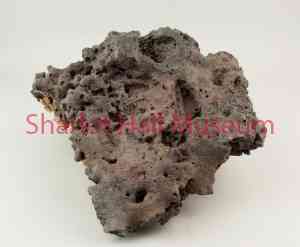By Dave Lewis
Normally, Sharlot Hall Museum and some 125 Indian artists would be getting ready for the annual Prescott Indian Art Market at this time of year. However, due to COVID-19, the market has been postponed to September 19-20. Since we are thinking about Indian art and history, Days Past would like to share this two-part story.
THE GROUND TREMBLED, A BIG BLACK SMOKE CAME. And there were people here to witness it and to have their lives affected by it.
For six million years there has been volcanic activity in the Flagstaff area -- activity that built the San Francisco peaks. Geologists have determined the focal point of the eruptions is generally moving eastward. Peaks many millions of years old lie to the west, with successively younger peaks to the east, ending (for now, at least) with the youngest - Sunset Crater - which erupted around the year 1085.
Geologist Bill Wade summarizes the current scientific information on the Sunset Crater eruption: It came in a series of distinct, but overlapping, events, all occurring within a year, maybe less. Earthquakes and smoke gave way to red-hot lava shooting from a fissure six and a half miles long creating a “curtain of fire.” “Gradually”, writes Dr. Wade, “the eruption became confined to the Sunset vent. The cinder cone built to a height of 1000 feet; cinder fallout blanketed 900 square miles.” Lava flows covered several thousand acres.
This might have gone unnoticed 900 years ago, only to be regarded today as just another interesting geologic feature of the Arizona landscape. Except, in 1085, there were people living where the cinders fell and the lava flowed. The National Park Service, which manages Sunset Crater as a National Monument, notes: “People had been living here for several hundred years, at least, before the volcano erupted . . . archaeologists consider them representatives of the Sinagua culture. They were farmers, living in scattered groups adjacent to their corn fields.”
They lived in pit- houses partially dug into the ground. [A full-size representation of a pit-house is displayed in the Pre-History exhibit at the Sharlot Hall Museum.]
The eruption must have set trees and grasses afire. Corn fields would have been blanketed in cinder and ash. Nearby pit-houses burned, filled with cinder, or disappeared beneath lava. The Park Service suggests that people in the area had sufficient warning to get out of the way; there is no evidence people died as a direct result of the eruption.
 The area near the eruption became un-livable and un-farmable. National Park Service: “People relocated, some to nearby Walnut Canyon and others to Wupatki, where they found that thinner layers of ash and cinders actually benefitted crops by holding moisture in the soil.” Agriculture and trade (including regular trade with the Prescott Culture) “flourished for about 100 years before people once again moved on. Their descendants, including the Hopi and Zuni, still live nearby; memories of the eruption live on in their stories and traditions.”
The area near the eruption became un-livable and un-farmable. National Park Service: “People relocated, some to nearby Walnut Canyon and others to Wupatki, where they found that thinner layers of ash and cinders actually benefitted crops by holding moisture in the soil.” Agriculture and trade (including regular trade with the Prescott Culture) “flourished for about 100 years before people once again moved on. Their descendants, including the Hopi and Zuni, still live nearby; memories of the eruption live on in their stories and traditions.”
Even though no inhabitants were killed by the eruption, some dared to approach it and place small ears of fresh corn near small spattering vents called “hornitos.” As the molten rock cooled, remarkably detailed imprints of the corn were sealed inside. In better specimens of these “corn rocks”, you can even see the “dimple” at the tip of each grain, indicating they were not yet fully ripe.
Contemporary volcanologists, trying to understand the process by which the corn rocks were formed, studied the action of hornitos at Mt. Kilauea in Hawaii. They think they have the answer.
In Part 2, we will discuss these corn rocks and the Hopi story of the eruption that has been passed down for more than 900 years.
“Days Past” is a collaborative project of the Sharlot Hall Museum and the Prescott Corral of Westerners International (www.prescottcorral.org). This and other Days Past articles are also available at https://www.sharlot.org/articles/days-past-articles.l. The public is encouraged to submit proposed articles and inquiries to dayspast@sharlothallmuseum.org. Please contact SHM Research Center reference desk at 928-445-3122 Ext. 2, or via email at archivesrequest@sharlothallmuseum.org for information or assistance with photo requests.


